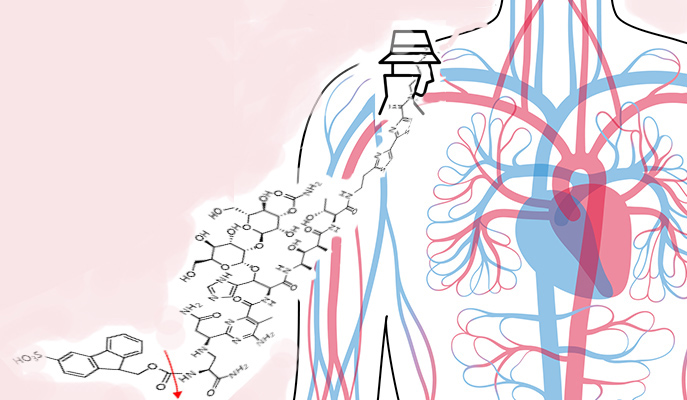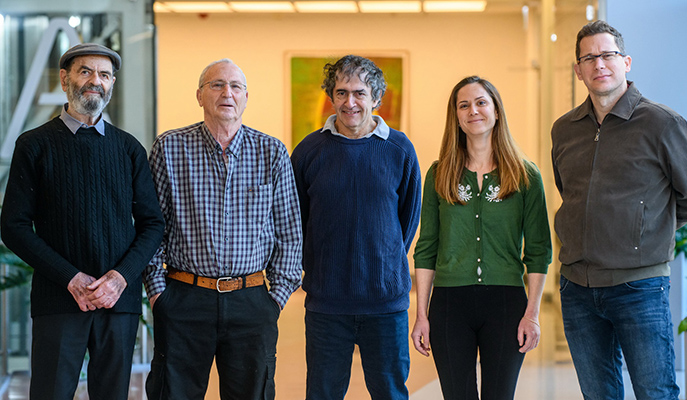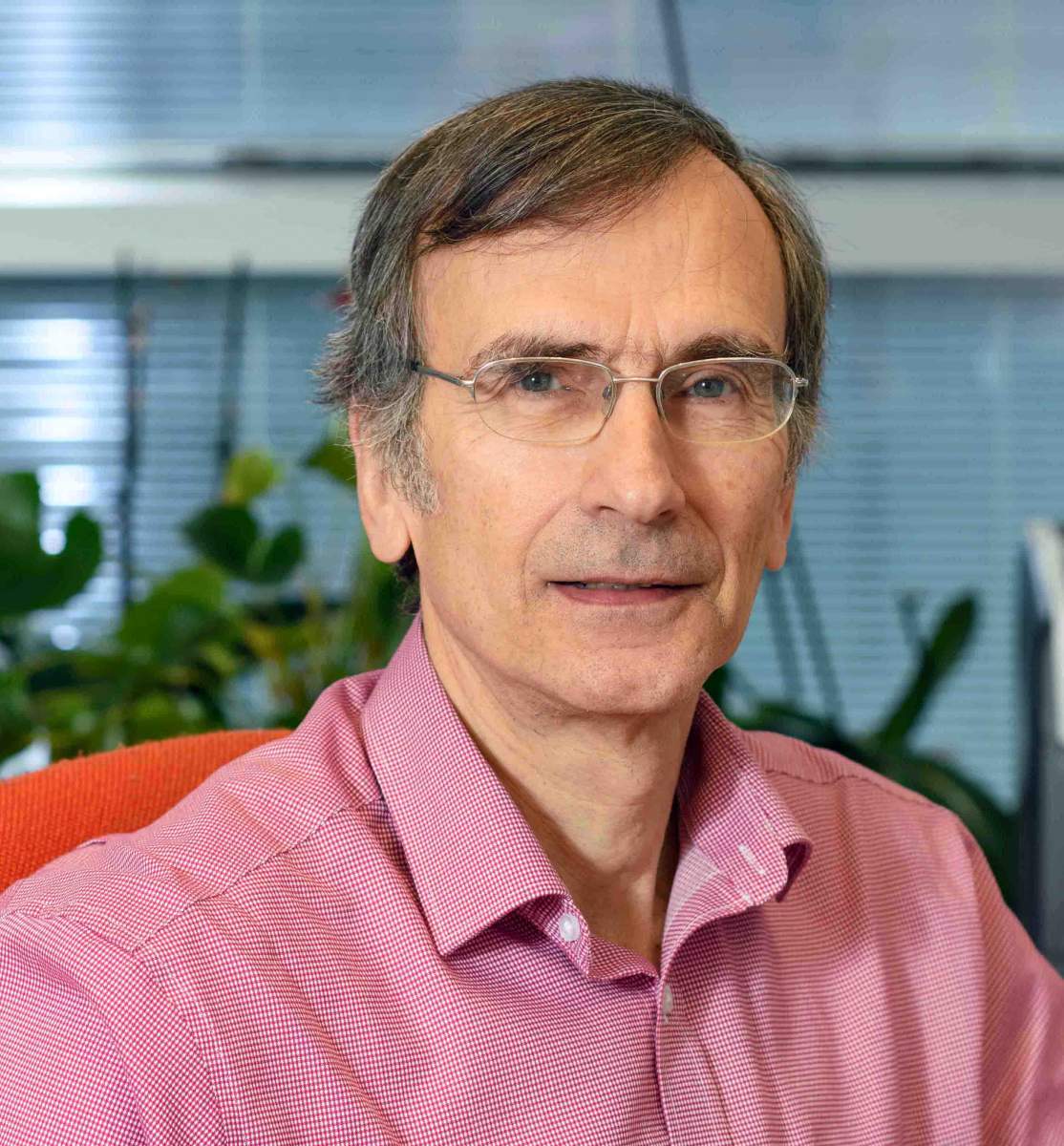Are you a journalist? Please sign up here for our press releases
Subscribe to our monthly newsletter:

Invisible ink, beloved of spies and spy novelists, stays hidden from prying eyes until the intended reader uses the proper method to bring the writing to light. Weizmann Institute of Science researchers have created their own drug version of invisible ink: “Sleeper” molecules that circulate undetected in the bloodstream until a natural chemical process in the body activates them. Such covert drugs might remain viable in the bloodstream for longer than usual, and they could maintain a measured level of activity that would, on the one hand, minimize side effects and, on the other, keep levels high enough to be effective in treating the disease. Such methods could be especially useful for chemotherapy drugs, which are given in relatively high doses so as to kill the cancer cells, but which often come with harsh side effects. As the group recently reported in Toxicology and Applied Pharmacology, they created such a covert version of a chemotherapy drug (Bleomycin) that is known, among other things to cause scar tissue to form in the lungs, leading to dangerous pulmonary fibrosis.
The idea of a sleeper drug – one dressed in protective “pajamas” it can slip off once inside the body so as to become activated – has been around since the 19th century. But the search for such drugs – or prodrugs, as they are called – is still going on today, as researchers look for ways to make them safe and effective. In the first decade of the 2000s, Prof. Yoram Shechter of the Biomolecular Sciences Department and Prof. Matityahu (Mati) Fridkin of the Organic Chemistry Department developed new means of producing prodrugs. They attached a sort of molecular “stopper” that gets broken down inside the body. The breakdown in the body was designed to be random and spontaneous, so little by little, the drug would be returned to its original active form in the bloodstream.
“Chemotherapy drugs that are administered by injection are good candidates for this technology, because maintaining a proper concentration in the bloodstream over time requires repeated injections, and the risk of harsh side effects is high,” say Shechter and Fridkin. Working together with Prof. Michael Walker of the Biomolecular Sciences Department and with Drs. Dana Atrakchi and Itzik Cooper of the Chaim Sheba Medical Center, the researchers focused on Bleomycin, a drug used to treat a variety of cancers including Hodgkin’s lymphoma, and ovarian and cervical cancers.

This team turned to Prof. Amnon Horovitz of the Institute’s Structural Biology Department, who assisted them in developing a mathematical model for predicting the prodrug’s pharmacokinetic profile – that is, how it would be absorbed and metabolized, how it would be removed from the body and possible toxicity. This model took just four factors into account: the concentration of the prodrug in the bloodstream right after it was administered, the half-life of the prodrug (when its concentration in the blood was half the original amount), the rate of conversion from invisible, inactive molecule to active drug, and the half-life of the active drug in the body. They then tested the Bleomycin prodrug on mice, and their findings showed that the model they developed had successfully predicted how the drug would be released in the body. This model, the scientists say, could be adapted for other prodrugs to help determine optimal doses for patients.
Shechter and Fridkin say no prodrugs under development today are based – as their method is – on this sort of slow-acting, spontaneous chemical reaction. (A second approach, in which the body’s enzymes release the drug molecules, tends to occur rapidly once the drug is introduced.) The Weizmann technique – essentially breaking off the stopper from the drug molecule – is an excellent way to maintain a steady concentration of the drug in the body, keeping it between the high and low thresholds so that there is enough to be effective, but not so much that dangerous side effects ensue. The familiar “controlled release” methods are not true prodrugs: They rely on a sort of packaging that breaks down slowly in the bloodstream. While these do make the drug actions last longer, many do not preserve the pharmacokinetic properties of the drugs to the same degree as the Weizmann technique. The team is currently continuing this research on further chemotherapy drugs.

The tennis club
Fridkin and Shechter are both emeritus professors, and their collaboration has been going on for 22 years. “Mati and I both came up through the lab of the late Prof. Abraham Patchornik, but he is a chemist, and I am a biologist. Biologists, as a rule, do not speak the language of chemists and vice versa. But we understand each other well. Good communication is essential to our scientific achievement,” says Shechter. “Since we are both getting older, we recruited to this research Dr. Cooper, who had been a research student in the lab of the late Prof. Vivian Teichberg and then a postdoc in my lab.”
Four professors at the Institute and one former postdoc all worked together on the study, but they are connected to one another by play, as well: Four of them, Shechter, Horovitz, Walker and Cooper, are keen tennis players. “I’m the odd man out in this group, but my grandson recently learned to play tennis and he is very enthusiastic,” says Fridkin, whose sports of choice when he was younger were basketball and volleyball.
Prof, Amnon Horovitz's research is supported by the Helen and Milton A.Kimmelman Center for Biomolecular Structure and Assembly; the Ilse Katz Institute for Material Sciences and Magnetic Resonance Researc; and the Mont-Royal Trust. Prof. Horovitz is the incumbent of the Carl and Dorothy Bennett Professorial Chair of Biochemistry.
Prof. Michael Walker's research is supported by the David and Fela Shapell Family Center for Genetic Disorders Research; the Kekst Family Institute for Medical Genetics; the Dr. Beth Rom-Rymer Stem Cell Research Fund; the Horowitz/ Kaufman Diabetes Research Fund; the Florence Blau, Morris Blau and Rose Peterson Fund; and the estate of Albert Engleman. Prof. Walker is the incumbent of the Marvin Myer and Jenny Cyker Professorial Chair of Diabetes Research.